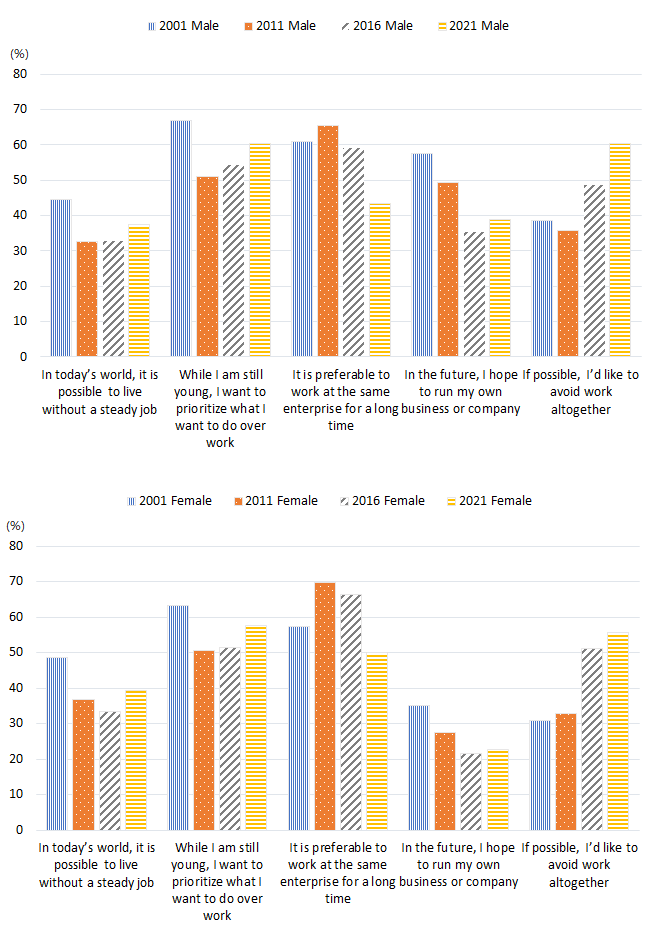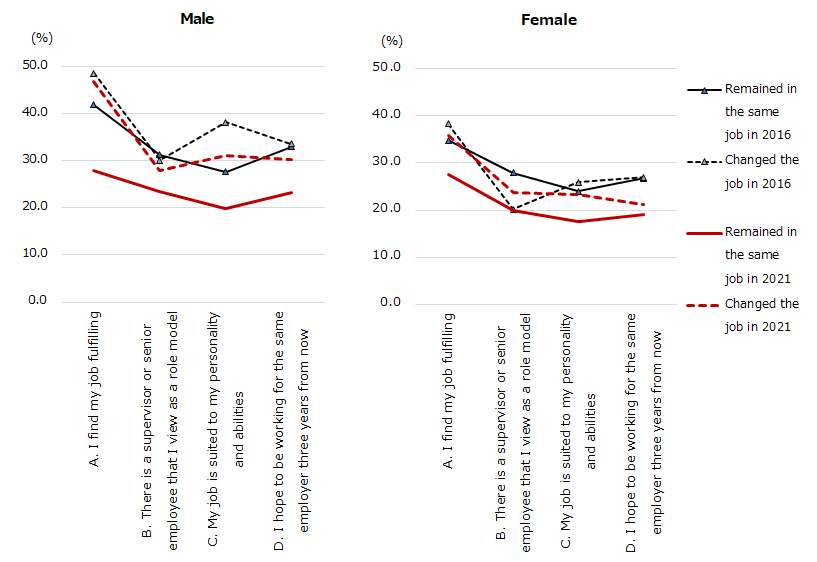JILPT Research Report No.213
Changes in Work and Consciousness of Youth in Major Urban Areas: From the 5th “Survey on the Working Style of Young People”
March 10, 2022
Summary
Research Objective
To understand changes in the working styles and consciousness of youth over the last 20 years, and assess the current situation.
Research Method
Questionnaire survey (request to respond to a survey sent by post to 8,000 young people in Tokyo, randomly selected from the Basic Resident Register. Responses were accepted both by post and on the web). The valid response rate was 39.5%.
Key Findings
Decrease in conversion to regular employment
Reflecting a strong labor market during the last five years, the percentage of people entering full-time employment immediately after leaving school increased and that of those entering non-regular employment immediately after leaving school relatively decreased, both with the exception of female high school graduates and those who withdrew from school. On the other hand, there was a particularly notable decline in the percentage of men who were non-regular employees immediately after leaving school making a subsequent transition to regular employment.
As to the work mentality of those who remain in non-regular employment, there are high percentages of those who do not care whether they are regular employees or “freeters” (young people in atypical employment) if they can do jobs they want to do, and those who have difficulty working due to depression or disability. Among non-regular employees, regarding “freeters” in particular, the percentage of those transitioning from being “freeters” to being regular employees has fallen over the past five years. It can be inferred that a certain number of those remaining in non-regular employment have their own reasons for doing so.
Changes in work mentality of young people
Regarding the work mentality of young people over the last 20 years, there had been a consistent decline in empathy with “freeters” and corresponding increase in orientation toward “steadiness.” However, the 5th survey showed significant changes of tendency.
Among both men and women, empathy with “freeters” (agreement with the statements “In today’s world, it is possible to live without keeping one steady job” and “While I am still young, I want to prioritize my own goals”) had been on a downward trend, but it rebounded. Single-company orientation (those stating “It is preferable to work at the same enterprise for a long time”) dropped significantly, while orientation toward independence (self-employment, etc.) plateaued at a low level. On the other hand, there was a significant rise in disinterest in work (exemplified by the statement “If possible, I’d like to avoid work altogether”). Loss of interest in work and weakening of orientation toward steadiness and reliability can be regarded as major changes from trends observed over the last 20 years.
Figure 1. Changes in work mentality of young people (excerpt)
Top row: Male Bottom row: Female

Changes in mentality of those remaining with one employer and those changing jobs
One notable characteristic of this survey was a decreased sense of fulfillment among regular employees remaining with a particular employer.
The regular employees’ evaluations of their current jobs below is categorized by career path, and from various perspectives, the percentages of those who find work fulfilling in 2021 was clearly lower among regular employees who have remained with one employer than among who have changed jobs. There were signs of this in the 2016 survey, but the trend has become more pronounced.
Figure 2. Regular employees’ evaluation of their current jobs, by career path

Also, from the vantage point of mentality toward work in general, those remaining regular employees of the same enterprise show strong single-company orientation, but there has been a weakening in orientation toward independence (running one’s own business or freelancing), conveying the sense of resignation, i.e. that people are choosing to stay with a single employer even though they do not find jobs fulfilling.
It is difficult to know how the context of young regular employees’ declining sense of fulfillment should be interpreted, but over the past five years, while disinterest in work has spread among all young people, there has also been a rise in workers’ changing jobs without falling into the category of “those leaving jobs at an early stage.” Among those changing jobs, the percentage stating “I do not know what kind of job suits me” fell after exploration of career options in the process of changing jobs, while on the other hand, the percentage expressing confusion and stating “I do not know what kind of job suits me” rose among those remaining in the same job. Such findings can be interpreted in terms of increased difficulty in finding fulfillment in one’s current job amid such confusion, and in terms of uncertainty about future career prospects at the current employer.
Policy Implications
- Support in response to changes among young non-regular employees: Young people who are in non-regular employment for reasons other than inability to become regular employees are not highly motivated to visit agencies offering support, so it is vital that efforts be made to further expand the network of public institutions including schools, and focus in particular on cooperation and referrals. However, if the economy worsens, it is certain that in addition to an increase in the number of “freeters,” there will be changes not only in mentality but also in the reality of the employment market. It is necessary to be prepared for an economic downturn.
- Support for young regular employees: Changes in work mentality (decline in orientation toward steadiness and reliability and toward staying with one company, growing disinterest in work, decline in aspiration toward independence) are progressing across the entire youth cohort. An increase in the number of regular employees changing jobs contributes to rising uncertainty among regular employees who stay with the same employer, but the latter are lacking in vision of future careers. Under these circumstances, it would be effective to expand support for young regular employees (via a “Self Career Dock,” a reference to the thorough medical checkup known as “Ningen Dock”). In particular, it is vital to enhance support uniquely geared toward young people, such as promotion of self-understanding. Furthermore, career education has thus far been characterized by setting forth regular employment immediately after graduation as ideal, but in the future, there will need to be an approach that takes into consideration not only the goal of being hired, but also what lies in the future.
Contents
- JILPT Research Report No.213, full text (PDF:6.6MB) [in Japanese]
Research Period
FY2020-FY2021
Authors
- HORI Yukie
- Vice Senior Researcher, Japan Institute for Labour Policy and Training
- KOSUGI Reiko
- Senior Fellow, Japan Institute for Labour Policy and Training
- RYU Hwangseok
- Research Assistant, Japan Institute for Labour Policy and Training
- OGURO Megumi
- Adjunct Instructor, Akita University
Category
Transitions to employment / Career development among youth
For Citation
JILPT. 2022. Daitoshi no wakamono no shugyo kodo to ishiki no henyo [Changes in Employment Behavior and Perceptions of Young People in Major Cities: From the 5th Survey on the Working Style of Young People]. JILPT Research Report no.213. Tokyo: The Japan Institute for Labour Policy and Training.
Related Research
- JIL Research Report No.146, Employment Behavior and Perceptions of Young People in Major Cities: Growing Experience with and Empathy for "Freeter"-style Employment (2001) (former Japan Institution of Labour)
- JILPT Research Report No.72, School-to-Work Transition and Employment of Youth in Tokyo: For Comprehensive Support to Transition (2006) (PDF:95KB)
- JILPT Research Report No.108, Employment Behavior and School-to-Work Transition of Provincial Youth (2009) (PDF:96KB)
- JILPT Research Report No.148, Work and Consciousness of Youth in Tokyo: From "The Third Survey on the Working Style of Young People" (2012) (PDF:211KB)
- JILPT Research Report No.154, Work and Consciousness of 30s in Tokyo: From "The Survey on the Working Style of 30s (2013)
- JILPT Research Report No.199, Disparities in Career Decisions and Perceptions among Young People in Major Urban Areas: Based on the 4th Survey on the Working Style of Young People (2017)
JILPT Research Report at a Glance
| To view PDF files, you will need Adobe Acrobat Reader Software installed on your computer.The Adobe Acrobat Reader can be downloaded from this banner. |

